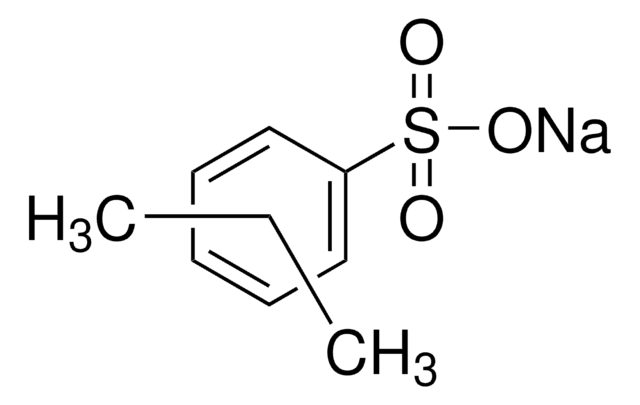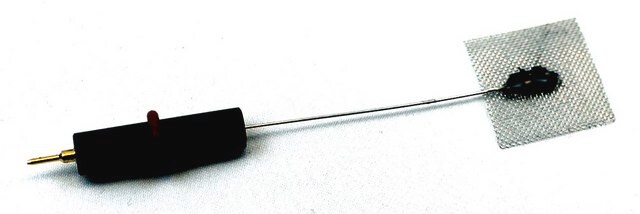Alle Fotos(1)
Wichtige Dokumente
267244
Platin
foil, thickness 0.025 mm, 99.9% trace metals basis
Synonym(e):
Platinum element, Platinum gray
Anmeldenzur Ansicht organisationsspezifischer und vertraglich vereinbarter Preise
Alle Fotos(1)
About This Item
Empirische Formel (Hill-System):
Pt
CAS-Nummer:
Molekulargewicht:
195.08
EG-Nummer:
MDL-Nummer:
UNSPSC-Code:
12141734
PubChem Substanz-ID:
NACRES:
NA.23
Empfohlene Produkte
Qualitätsniveau
Assay
99.9% trace metals basis
Form
foil
Widerstandsfähigkeit
10.6 μΩ-cm, 20°C
Dicke
0.025 mm
bp
3827 °C (lit.)
mp (Schmelzpunkt)
1772 °C (lit.)
Dichte
21.45 g/cm3 (lit.)
SMILES String
[Pt]
InChI
1S/Pt
InChIKey
BASFCYQUMIYNBI-UHFFFAOYSA-N
Verwandte Kategorien
Allgemeine Beschreibung
This platinum foil is a thin sheet of platinum with a thickness of 0.025 mm and high chemical purity. Platinum is a dense, silver-white metal that is highly resistant to corrosion and has a high melting point. Platinum is a precious metal that is valued for its rarity and chemical stability, and is often used in jewelry, coins, and other decorative objects. In material science, it is often used as electrodes in fuel cells, batteries, and other electrochemical devices, as a substrate for electroplating, and as an inert crucible or dish among other applications.
Anwendung
Platinum foil can be used for a variety of applications such as:
- growth of high crystalline boron nitride (BN) material for UV optoelectronic devices.
- fabrication of electrochemically stable microelectrode arrays
- a counter electrode for the fabrication of supercapacitors
- an enzyme electrode probe for potential usage in biosensors
Menge
350 mg = 25 × 25 mm; 1.4 g = 50 × 50 mm
Lagerklassenschlüssel
13 - Non Combustible Solids
WGK
nwg
Flammpunkt (°F)
Not applicable
Flammpunkt (°C)
Not applicable
Hier finden Sie alle aktuellen Versionen:
Besitzen Sie dieses Produkt bereits?
In der Dokumentenbibliothek finden Sie die Dokumentation zu den Produkten, die Sie kürzlich erworben haben.
Kunden haben sich ebenfalls angesehen
Electrodeposition of nickel hydroxide films on nickel foil and its electrochemical performances for supercapacitor
Fu GR, et al.
International Journal of Electrochemical Science, 4(8), 1052-1052 (2009)
Pt based enzyme electrode probes assembled with Prussian Blue and conducting polymer nanostructures
Curulli A, et al.
Biosensors And Bioelectronics, 20(6), 1223-1232 (2004)
Muhammad Rashid et al.
Journal of nanoscience and nanotechnology, 13(5), 3627-3633 (2013-07-19)
Platinum nanoparticles (Pt NPs) were chemically deposited on a Nafion polymer electrolyte membrane by the impregnation-reduction (I-R) procedure to prepare an active electrode for solid electrochemical sensors. Various analysis methods such as SEM, EDX, XRD and cyclic voltammogram (CV) measurements
Wei Sun et al.
Materials science & engineering. C, Materials for biological applications, 33(4), 1907-1913 (2013-03-19)
In this paper a platinum (Pt) nanoparticle decorated graphene (GR) nanosheet was synthesized and used for the investigation on direct electrochemistry of myoglobin (Mb). By integrating GR-Pt nanocomposite with Mb on the surface of carbon ionic liquid electrode (CILE), a
Loris De Cecco et al.
PloS one, 8(3), e58849-e58849 (2013-03-14)
We recently reported that peritumoral CpG-ODN treatment, activating TLR-9 expressing cells in tumor microenvironment, induces modulation of genes involved in DNA repair and sensitizes cancer cells to DNA-damaging cisplatin treatment. Here, we investigated whether this treatment induces modulation of miRNAs
Unser Team von Wissenschaftlern verfügt über Erfahrung in allen Forschungsbereichen einschließlich Life Science, Materialwissenschaften, chemischer Synthese, Chromatographie, Analytik und vielen mehr..
Setzen Sie sich mit dem technischen Dienst in Verbindung.




